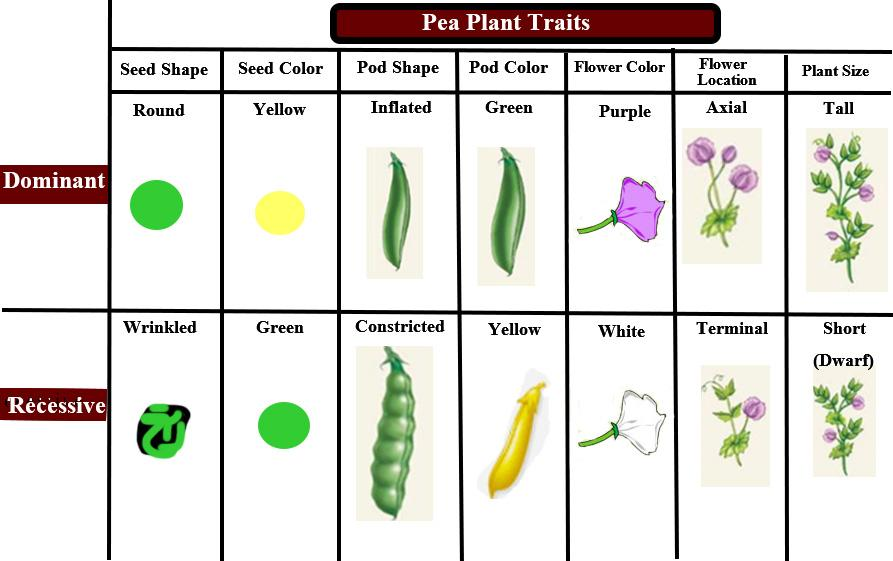
Name any four characters of the pea plant based on which Mendel studied inheritance.
Answer
496.8k+ views
Hint: The characters Mendel picked for his research were related to the flowers, stem, seeds, and seed coats of the pea plants. These characters showed variations in different pea plants.
Complete answer:
To research inheritance, Mendel used pea plants. In pea plants, he found seven distinct characters. They exhibit dominant and recessive characters. They are:
-Round or wrinkled pea shape
-The green or yellow color of the plant
-Constricted or inflated pod shape
-Green or yellow pod color
-Purple or white color flower
-Tall or dwarf plant size
-Axial or terminal position of flowers
Additional Information:
To do so, he first developed pea lines with two distinct feature types, such as tall versus short height. For generations, he grew those lines until they were pure breeding (still producing offspring similar to the parent), then bred them to each other, and observed how the traits were inherited. Besides documenting how the plants looked in each generation, Mendel counted the exact number of plants that showed each trait.
Naturally, pea plants self-fertilize, meaning pollen seeks ova within the same flora. The floral petals remain tightly sealed until pollination is completed to avoid further plant pollination. The outcome is strongly inbred pea plants, or "true-breeding." These are always plants that produce offspring that look like the parent. Mendel prevented the occurrence of unusual traits in offspring by dealing with true-breeding pea plants, which might occur if the plants were not true-breeding. The garden pea also grows to maturity within one season, which means that several generations can be measured within a relatively short period. Lastly, large amounts of garden peas could be grown at the same time, allowing Mendel to conclude that his findings didn't just come about by chance.
Note: A lifelong learner, author, scientist, and man of faith was Johann Gregor Mendel (1822–1884). Mendel's pioneering work was achieved by researching inheritance using the garden pea, Pisum sativum. Mendel also found that the characteristics were inherited independently: one characteristic, such as plant height, did not affect the inheritance of other characteristics, such as flower color or seed shape.

Complete answer:
To research inheritance, Mendel used pea plants. In pea plants, he found seven distinct characters. They exhibit dominant and recessive characters. They are:
-Round or wrinkled pea shape
-The green or yellow color of the plant
-Constricted or inflated pod shape
-Green or yellow pod color
-Purple or white color flower
-Tall or dwarf plant size
-Axial or terminal position of flowers
Additional Information:
To do so, he first developed pea lines with two distinct feature types, such as tall versus short height. For generations, he grew those lines until they were pure breeding (still producing offspring similar to the parent), then bred them to each other, and observed how the traits were inherited. Besides documenting how the plants looked in each generation, Mendel counted the exact number of plants that showed each trait.
Naturally, pea plants self-fertilize, meaning pollen seeks ova within the same flora. The floral petals remain tightly sealed until pollination is completed to avoid further plant pollination. The outcome is strongly inbred pea plants, or "true-breeding." These are always plants that produce offspring that look like the parent. Mendel prevented the occurrence of unusual traits in offspring by dealing with true-breeding pea plants, which might occur if the plants were not true-breeding. The garden pea also grows to maturity within one season, which means that several generations can be measured within a relatively short period. Lastly, large amounts of garden peas could be grown at the same time, allowing Mendel to conclude that his findings didn't just come about by chance.
Note: A lifelong learner, author, scientist, and man of faith was Johann Gregor Mendel (1822–1884). Mendel's pioneering work was achieved by researching inheritance using the garden pea, Pisum sativum. Mendel also found that the characteristics were inherited independently: one characteristic, such as plant height, did not affect the inheritance of other characteristics, such as flower color or seed shape.

Recently Updated Pages
Express the following as a fraction and simplify a class 7 maths CBSE

The length and width of a rectangle are in ratio of class 7 maths CBSE

The ratio of the income to the expenditure of a family class 7 maths CBSE

How do you write 025 million in scientific notatio class 7 maths CBSE

How do you convert 295 meters per second to kilometers class 7 maths CBSE

Write the following in Roman numerals 25819 class 7 maths CBSE

Trending doubts
State and prove Bernoullis theorem class 11 physics CBSE

What are Quantum numbers Explain the quantum number class 11 chemistry CBSE

Write the differences between monocot plants and dicot class 11 biology CBSE

1 ton equals to A 100 kg B 1000 kg C 10 kg D 10000 class 11 physics CBSE

State the laws of reflection of light

One Metric ton is equal to kg A 10000 B 1000 C 100 class 11 physics CBSE




